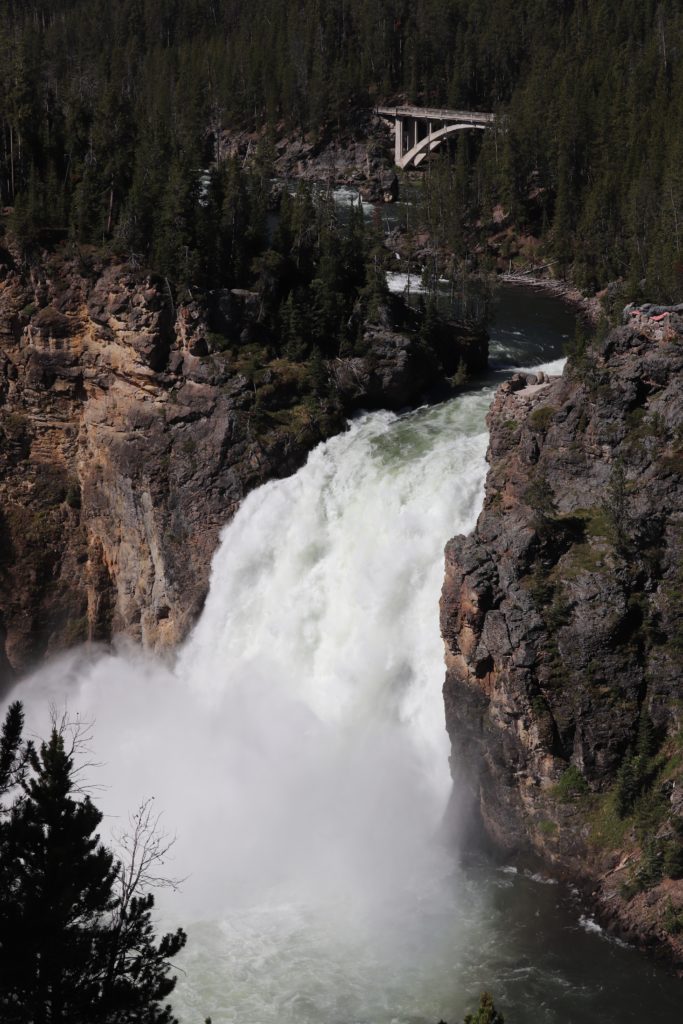
Spending a significant time in the West is one of our family’s favorite summer traditions. We’ve been doing it for 39 years and it goes back even further if you count my husband’s childhood. Over the last few weeks, I’ve been chronicling our 2019 trip to the Wind River Range of Wyoming and the stops we made afterwards. You can read Part I here, Part II here, and Part III here.
America’s Favorite National Park
After 8 days, we left our primitive camp in the Wind River Range to head north. Our two youngest had never seen Yellowstone which seemed unacceptable since they were practically adults now. So we pulled into a Yellowstone campground to spend 2 nights and a full day hitting the typical highlights of this unique park. One day is not near enough to see it all, but we had the perfect weather and made the best of it.
I’m going to assume most of you have either seen Yellowstone National Park in person or are very familiar with most of the sights there. For the purposes of this nature blog, I want to focus on a couple of iconic landscapes but mostly on its wonderful wildlife.
Below is the Lower Falls of the Yellowstone River at the peak of spring melt-off. The larger of the two most visited falls in Yellowstone, Lower Falls is 308′ tall, more than twice the height of Niagara Falls. However it’s flow rate is only 8,400 cu ft/s compared to Niagara’s 100,000 cu ft/s because Yellowstone’s Lower Falls is only 70′ across at the lip and Niagara is 2,600′ across the lip. The tans and oranges of the canyon limestone in morning light give it a beautiful setting.
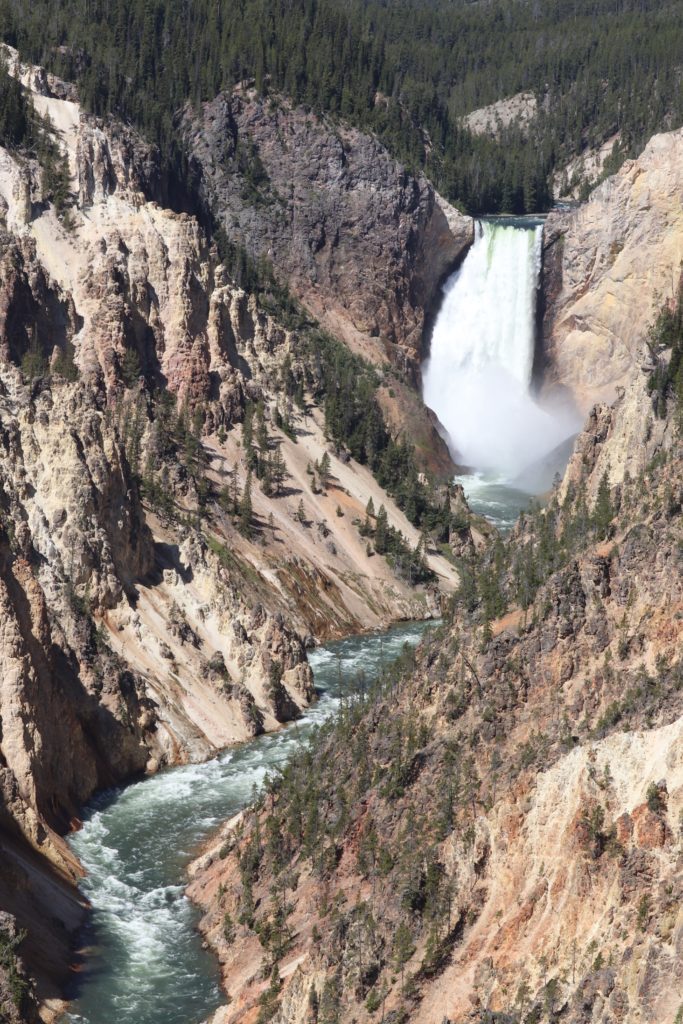
Residents of Yellowstone
Most known for its bison herds, Yellowstone is best visited in the spring when the herds feed on the new grass in the valleys and the calves are still little. The population of Yellowstone bison is estimated to be at 4,527 as of last fall. That’s pretty amazing when you consider in 1902, poachers had reduced Yellowstone’s herd to about 24 animals! Yellowstone is the only place in the lower 48 states to have a continuously free-ranging bison population. The National Park Service works with other federal, state, and tribal agencies to manage Yellowstone bison herds, controlling both the population and the extent of their range. But the bison are still very much wild, congregating during the breeding season to compete for mates, as well as migrating and exploring the thousands of acres in and near Yellowstone just like their ancestors did.
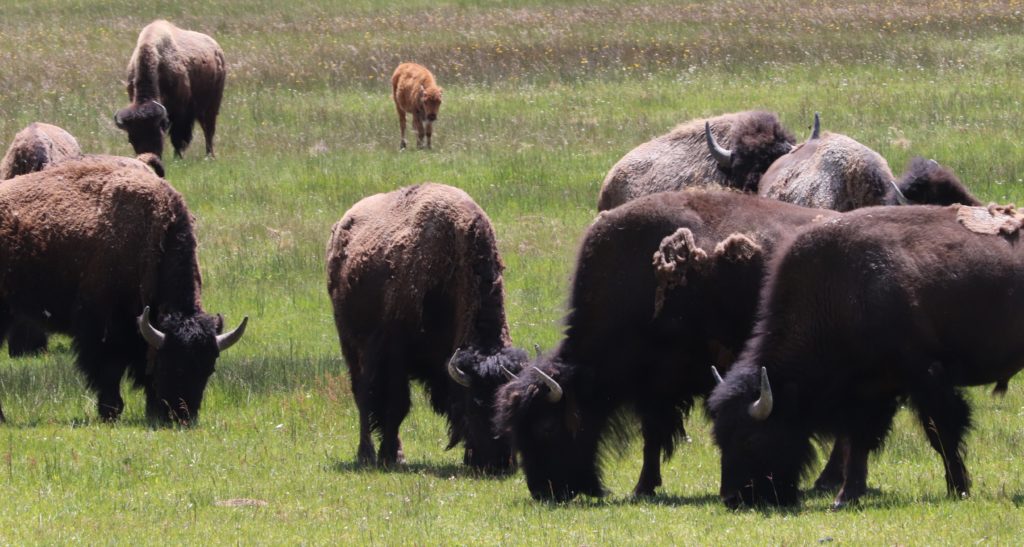
A lone bull was enjoying a dust bath alongside the river. Covering their hide in dirt helps keep insects from biting. Birds, such as the magpie, will perch on a bison’s back to feed on insects in its coat. I was hoping to see this in person, but our visit was early in the season so I doubt the insects were a huge problem yet.
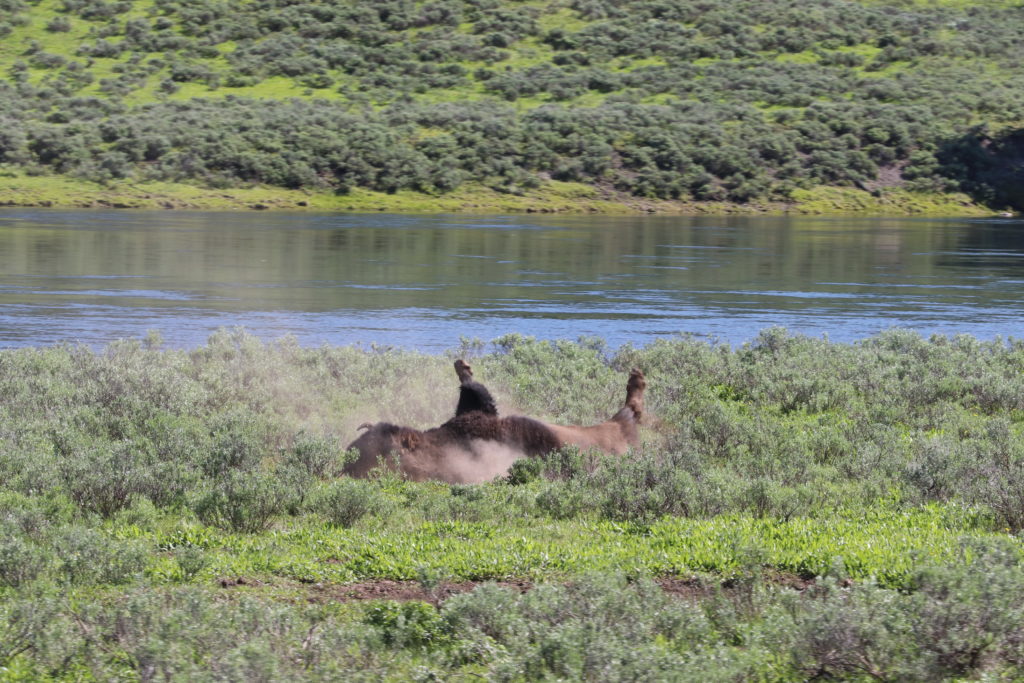
Stay clear
Ever think the front end a bison is out of proportion of the rear end? This clever design by the Creator allows the bison with their huge neck and shoulder muscles to swing their heads from side-to-side to clear snow from foraging patches. And though they may seem dumb and slow to the untrained eye, bison can jump over objects about 5 feet high and run 35 miles per hour. They also have excellent hearing, vision, and sense of smell. Unfortunately to the ignorant and oftentimes reckless visitor, bison can cause havoc and even tragedy if they feel threatened by the close proximity of people. This is where the cost of a telephoto lens pales in comparison to the risk of harm or death.
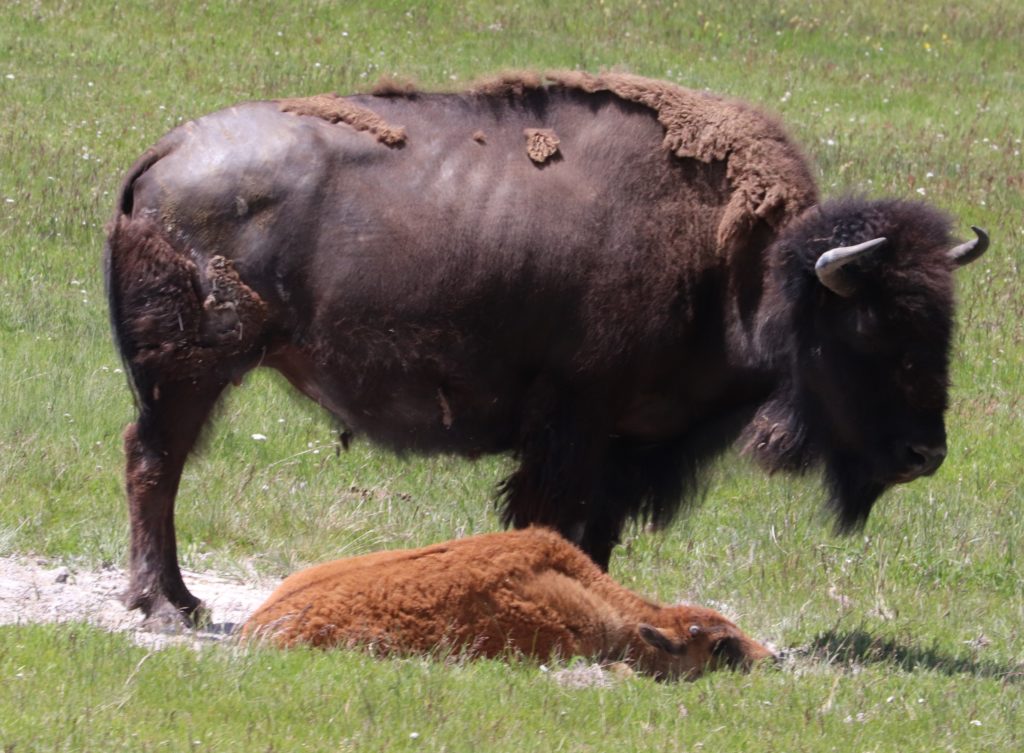
This is one scene you want to view from afar. These youngsters below are about a month old, soaking up the sunshine and taking a nap. Aren’t they beautiful in their tan coats? The hides will begin to turn brown after 2½ months. Each pregnant female will give birth to one calf in late April or May. Though just one or two adults are babysitting this group of calves, if a perceived threat occurred, the whole herd would come running to protect the babies. Not a good idea to get too close.
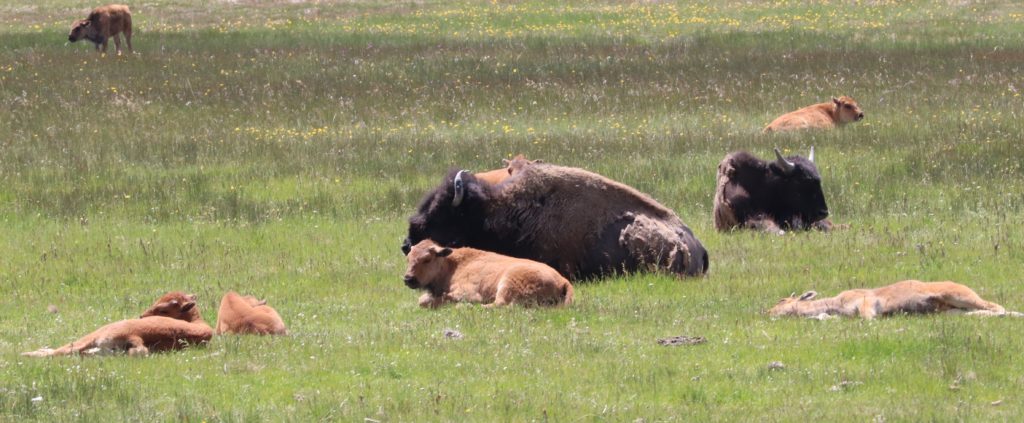
Yellow-bellied Marmots
While the rest of my family was hiking to an observation point over the Upper Falls of the Yellowstone, I became fascinated by a family of marmots along the trail. The parents had a group of 3-4 youngsters and they were all nibbling on grass or playing near the entrance to their den, mostly oblivious to me. The babies were unbelievably cute, tumbling over each other. Marmots are perfectly designed for life at high elevations with small fur-covered ears, short, stocky legs, a bushy tail and long, thick, coarse fur. We see them frequently throughout the Rockies and almost always sitting on top of a rock or boulder, alert to any intruder.
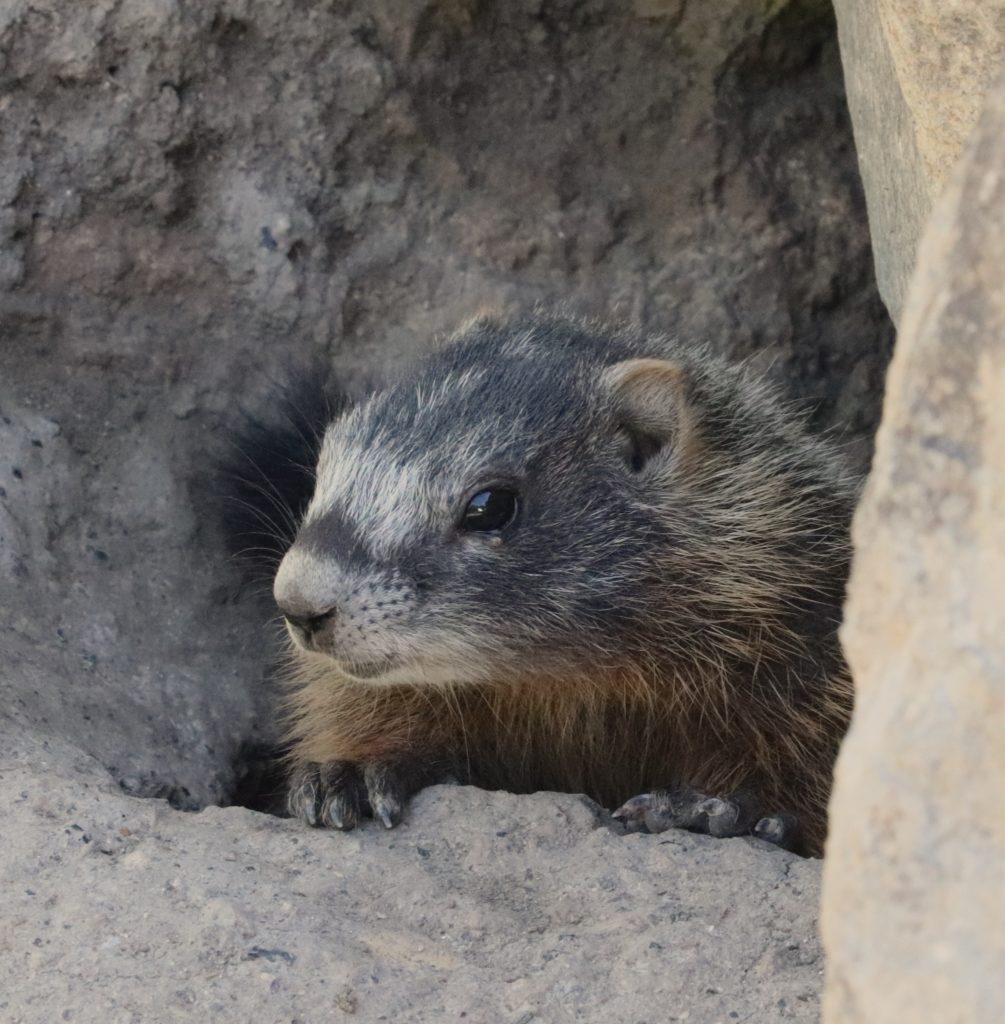
Like walking on glass
Yellowstone Lake is stunning, especially on a calm day when the water is like glass. It is the largest high-elevation lake (above 7,000 ft) in North America, covering up to 139 square miles, with an average depth of 138 feet. Looks inviting but believe me, it’s ice cold!
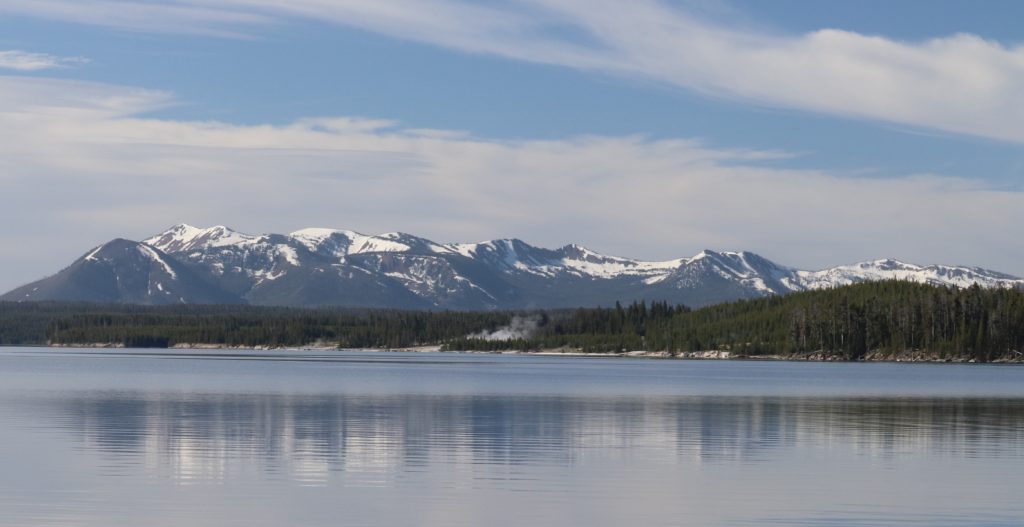
And you are, how old?
One of the first animals we saw upon entering the Park was this elk. Only the males have antlers and although the number of tines present on each antler is not indicative of an elk’s age, it does give a clue. Antler growth depends a lot on the abundance or lack of food. Bucks produce their first antlers, single spikes, during their second summer. A general premise is that by the time a buck is 7 years old, he usually has six tines on each antler. That’s what I’m counting here.
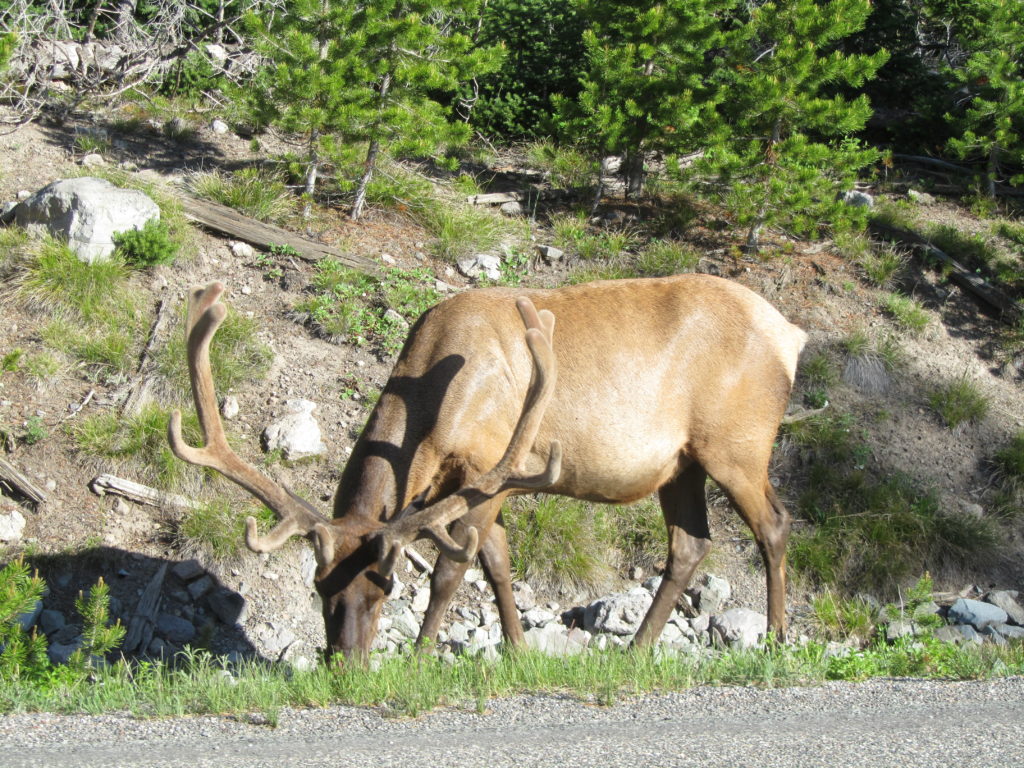
During spring and summer, the antlers are covered by a furry skin called velvet. Growth and hardening of the antlers is completed in late July or August. In August, increased production of testosterone cuts off the blood supply to the antlers and velvet. The velvet dies, dries up, and peels away, creating the sharp, large rack to impress the ladies or fight off the male competition during rutting season.
SCORE!
Sometimes it just goes your way and you get to cross one off the bucket list. Navigating the confusing road to the Lower Falls, my husband made a wrong turn and we ended up in a little parking lot for a trailhead. As he was turning the truck around, I saw something moving out the passenger window. A black bear meandered out of the woods, right toward the parking lot, about 50′ from our truck! Undisturbed by vehicles or people, unafraid, not all that curious or aggressive, he padded silently along to some unknown destination.
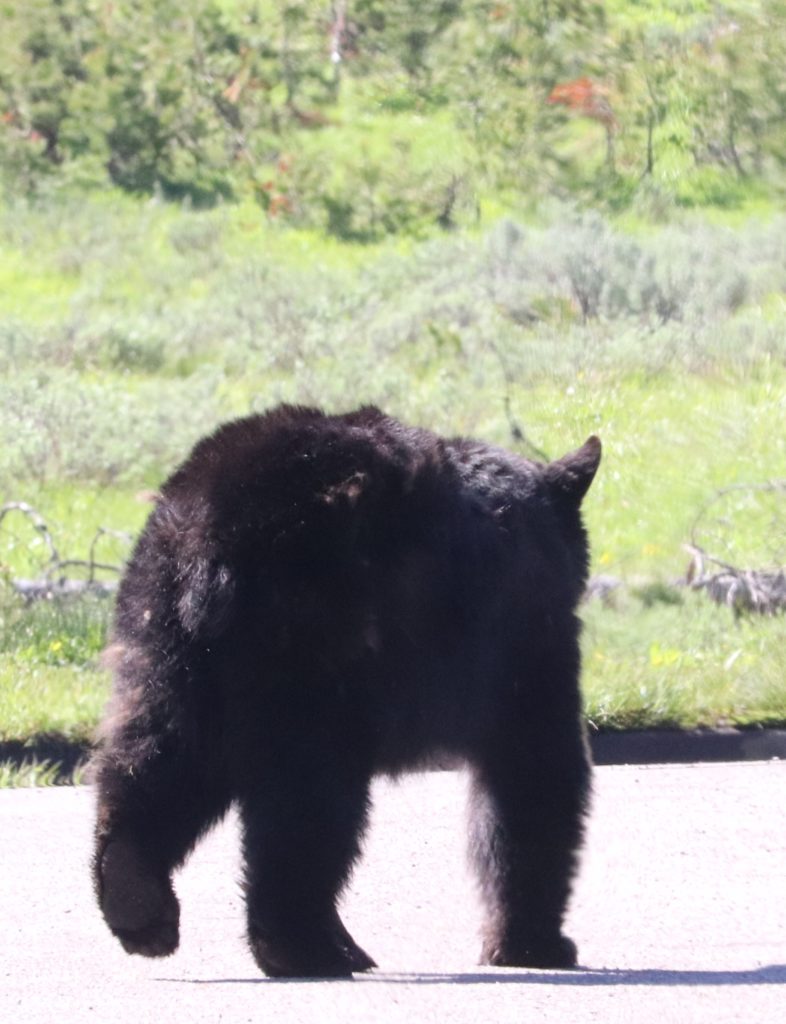
What an amazing sight! We camp in remote bear country frequently but it is so rare to see a bear this close, if at all. He/she definitely was acclimated to people which made me glad he was walking in the opposite direction. In both photos you can see the pads of his feet, bigger than my whole hand.
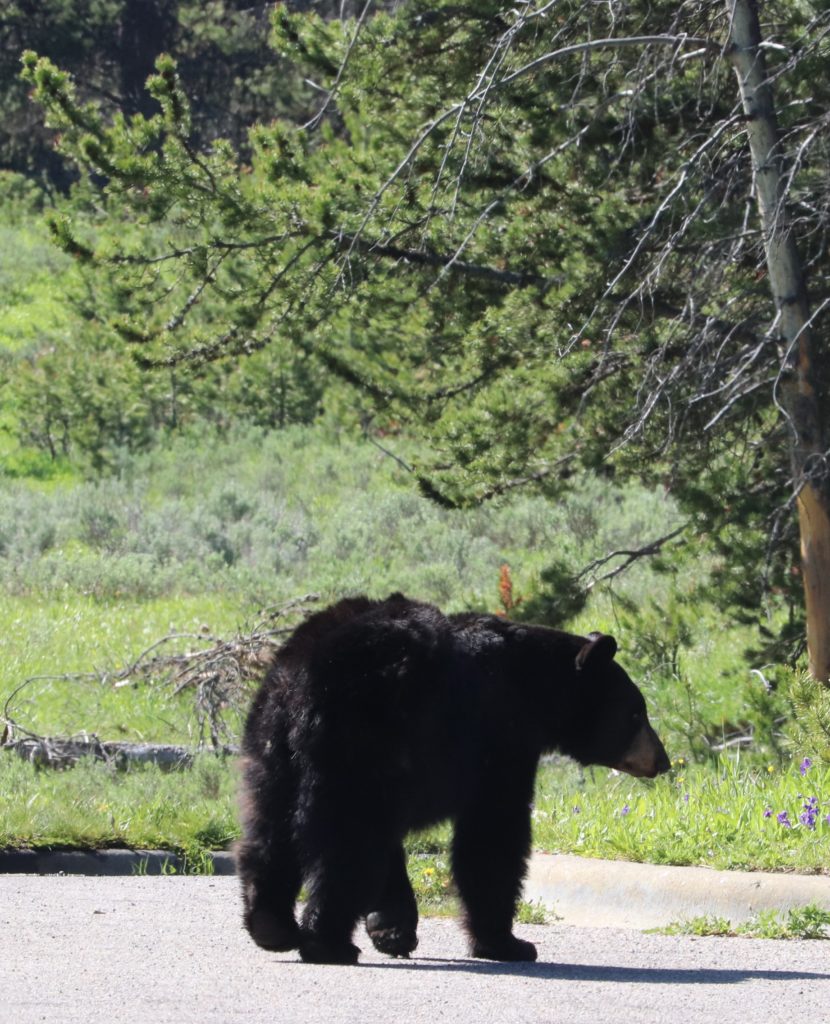
Creating art in nature
Fly-fishing is an art and it’s beautiful to watch. Even though my dad took me fishing often as a child, I don’t like to touch fish, smell fish or eat fish. But if I had the chance, I would like to learn to fly-fish. Maybe it’s the act being out IN the stream, IN nature alone, and IN-tune with the cast, the fly and the fish. Yep, one day.
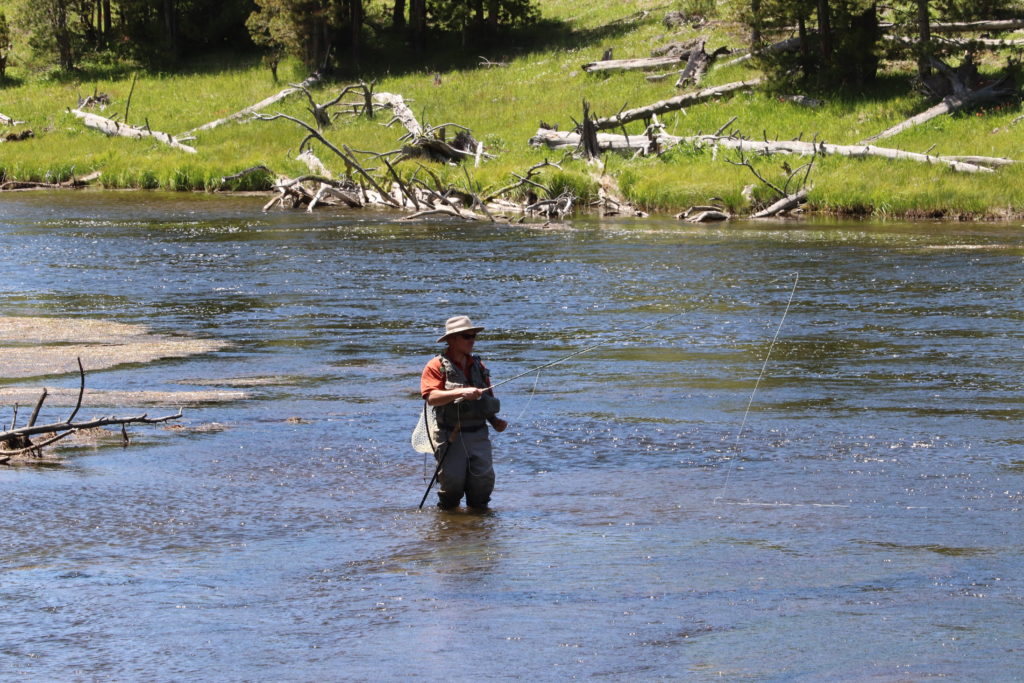
A HUGE Problem
Overcrowding of our national parks is a real problem for this generation. Zion and Yellowstone have over 4.3 million visitors a year, Yosemite hit 5 million in 2015 before setting limits on visitors and the Grand Canyon broke the 6 million mark in 2016. Why so many? “Baby boomers are retiring in droves – every day 7,000 to 10,000 people turn 65 and travel is high on their list. The threat of terrorism in Europe has also kept many people in the United States.” Social media has not only provided inspiration for the next vacation but has given a platform for thrill seekers to take dangerous selfies with an iconic backdrop. And internationals are being targeted by US National Park tourism campaigns that are obviously hugely successful.
Unmarred beauty
You might think the solution is to build more infrastructure, but the National Park Service has a two-fold mandate from Congress: to “provide for the enjoyment in such manner and by such means as will leave them unimpaired for the enjoyment of future generations.” Wider roads and more hotels and campgrounds would defeat the mandate and the purpose of establishing national parks, keeping these wild areas as they are. Teddy Roosevelt said, “There can be nothing in the world more beautiful than the Yosemite, the groves of the giant sequoias and redwoods, the Canyon of the Colorado, the Canyon of the Yellowstone, the Three Tetons; and our people should see to it that they are preserved for their children and their children’s children forever, with their majestic beauty all unmarred.”
The Wild places gone?
With international visitors at an all time high and American travel so affordable and easy in this age, how do we control all who want to see these hallowed places? Jim Robbins, a conservation writer says, “Saving a landscape as a national park is only part of the preservation battle – saving the spirit of these places is also essential. National parks are often thought of as America’s natural cathedrals – serene, contemplative places to visit and be restored by a connection to wild nature and grandeur.” I’m sad to say, that’s mostly impossible anymore. Why has my 19 year old never seen Yellowstone? Because it’s not a place we go to get recharged, refreshed, connected with nature. It’s wall to wall people, some acting badly and most of them unaware of and incapable of giving personal space.
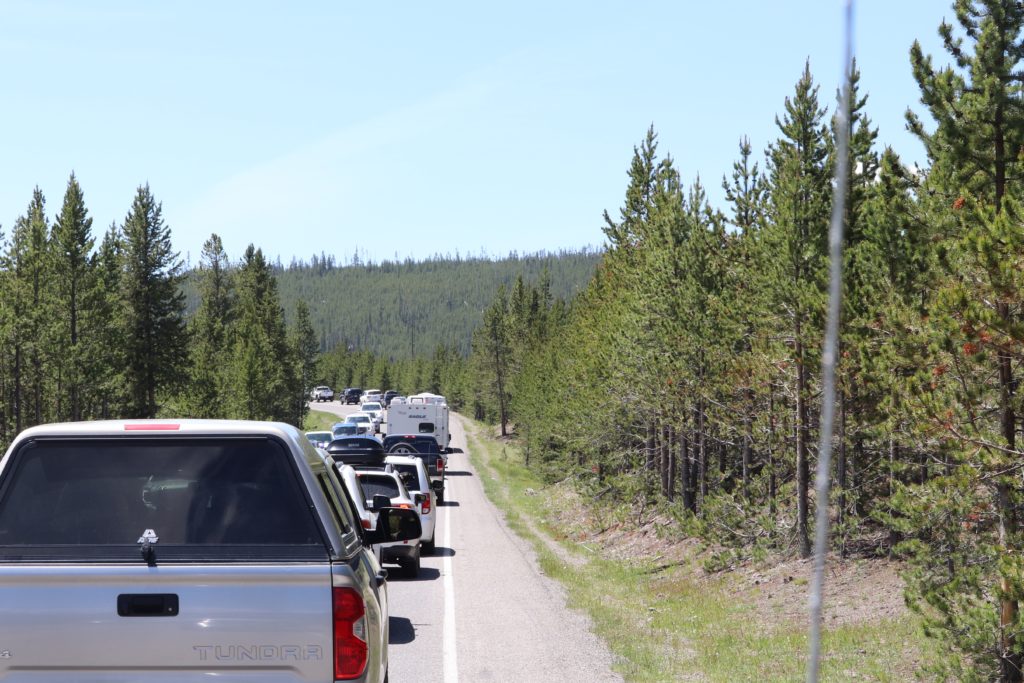
What’s the solution?
The huge numbers of people visiting the national park system is creating 2 major problems ~ a decline in the quality of a national park experience and the damaging effects on these “natural cathedrals.” Just using a restroom in Yellowstone was a torturous 30 minute wait for me. You can see the traffic, both cars and people, in the photos above and below, all prior to the typical peak season of July and August. The trash thrown in streams or the sewage left by visitors is getting to be a health hazard as well as an eye-sore.
I don’t know the answer, but seems like limitations, reservations, or lotteries are in the future for our national parks. The only way I’d recommend you visit a national park is off-season, and I mean WAY off-season!
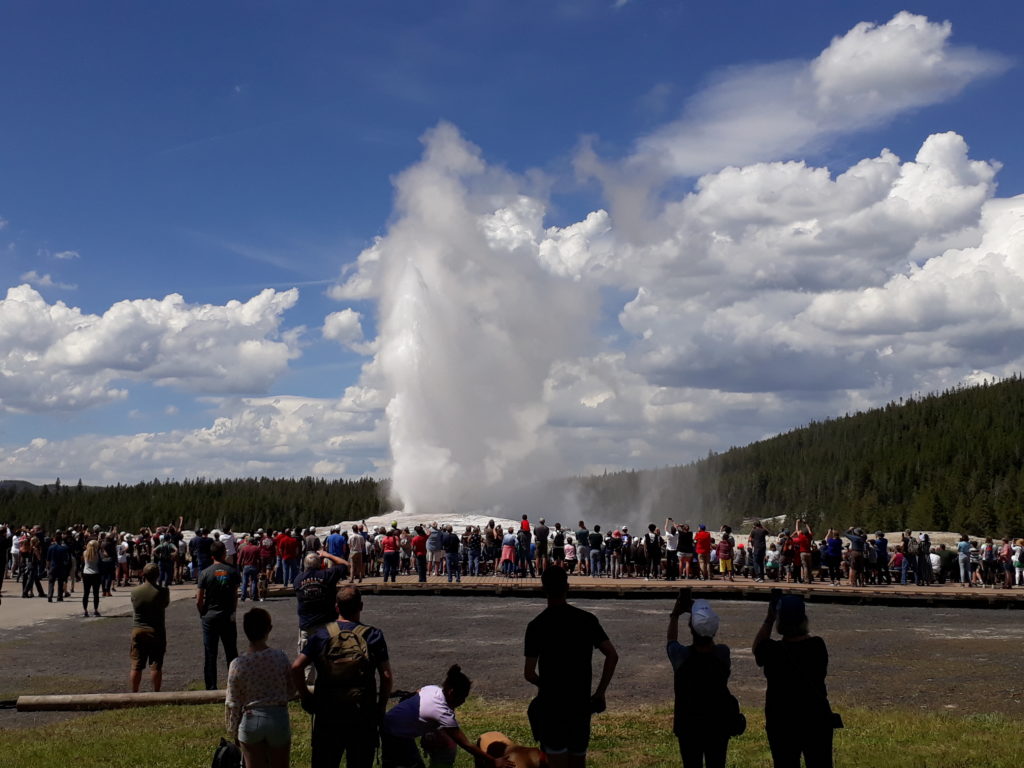
Cody
East of Yellowstone, we stopped at my all-time favorite museum, The Buffalo Bill Historical Center in Cody, Wyoming. This museum never gets boring. From a central lobby & cafe area there are 5 wings to explore, each dedicated to an aspect of the West. The 5 dedicated areas are: the Buffalo Bill Museum, the Plains Indians Museum, the Cody Firearms Museum, the Whitney Western Art Museum and the Draper Natural History Museum. Each of these alone are reason enough to stop, but together, it is a world-class collection not seen anywhere else.
A statue of Buffalo Bill as a Pony Express rider.
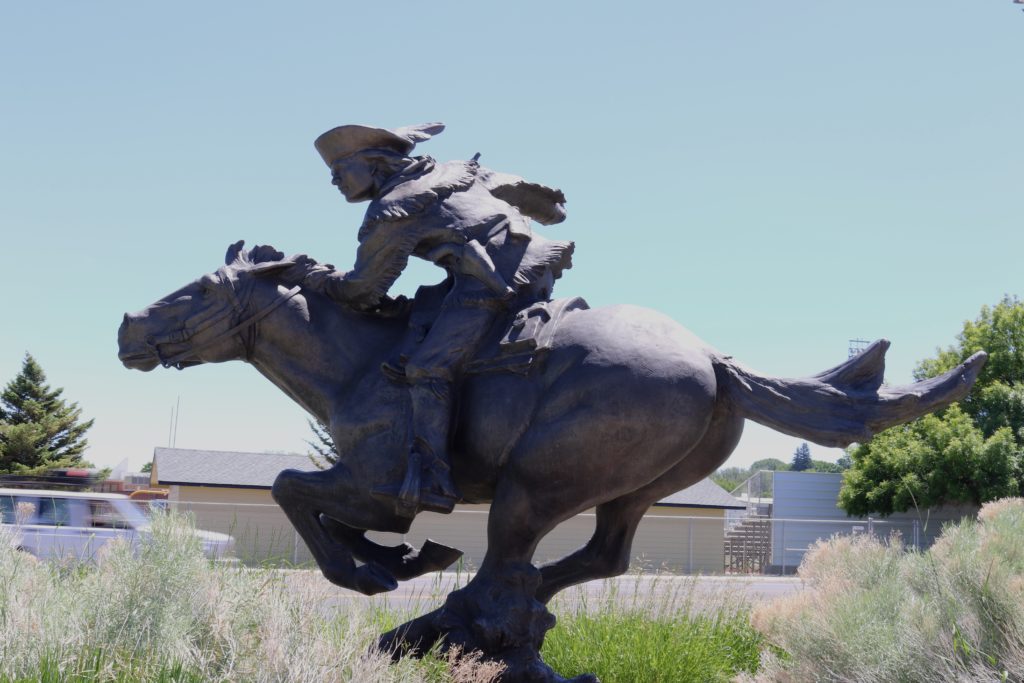
Below is an old photograph of Bill Cody as a US Army Scout. The coat and hat he is wearing and his rifle are preserved in the museum as seen below.
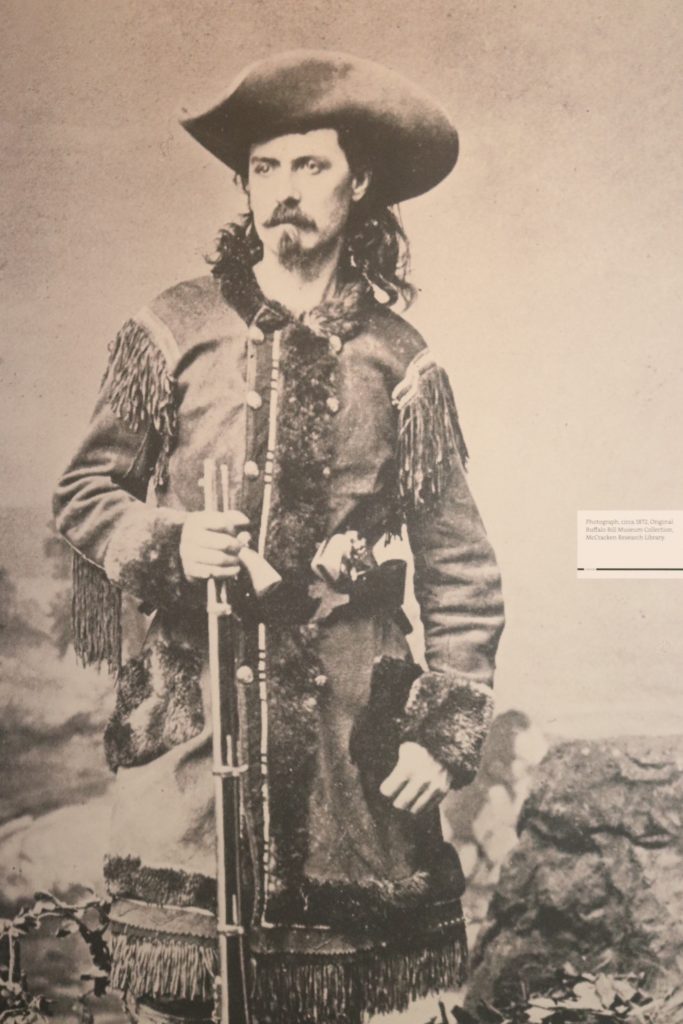
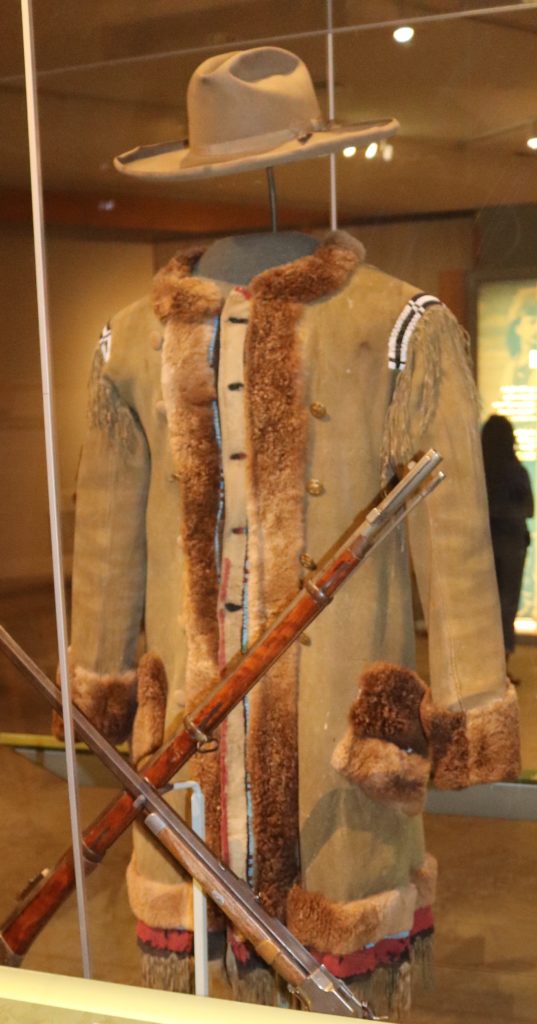
The Whitney Art Museum is outstanding, comprised of western paintings, bronze sculptures and Indian pottery. Below is a 1898 painting by Charles Russell, called The Robe Trader.
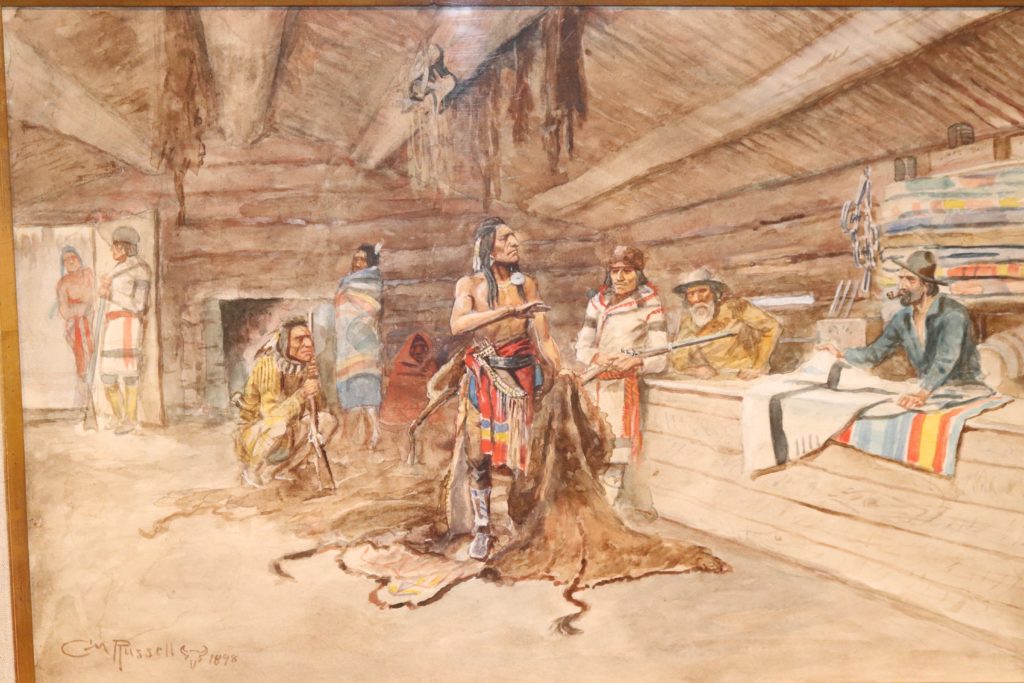
Thomas Moran is famous for his painting of the Yellowstone Falls. It rests in the Smithsonian in Washington DC. Moran’s colleague, Albert Bierstadt painted this of the Lower Falls after his 1881 trip to Yellowstone and it was hung in the White House. I love his effect of light and shadows in the canyon.
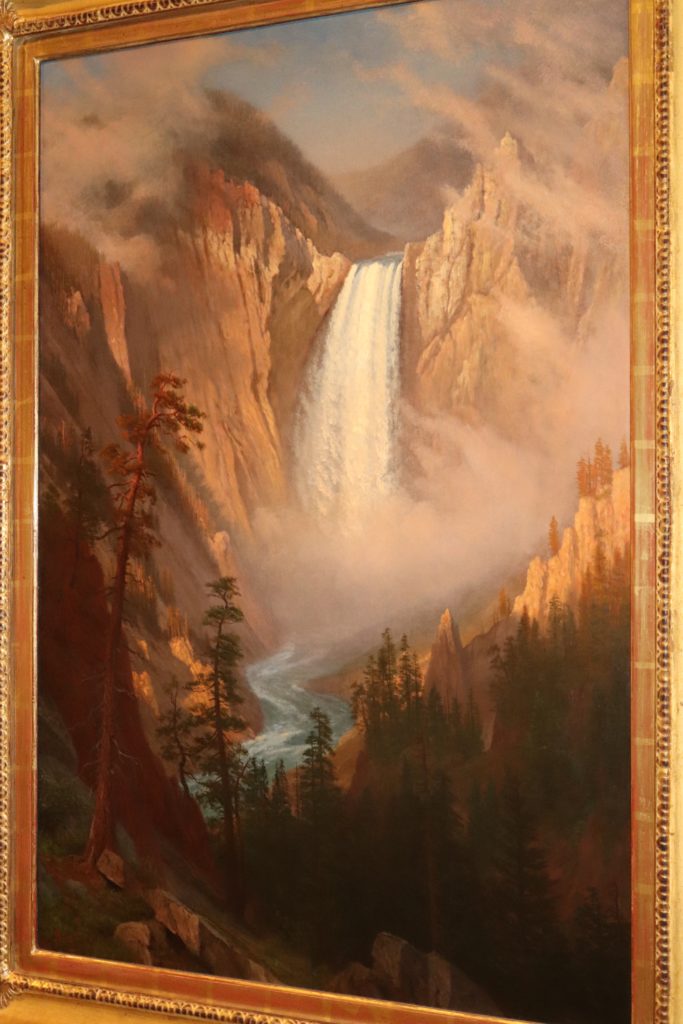
Bronze sculptures ranged from very large, like this 8′ life-size elk . . . .
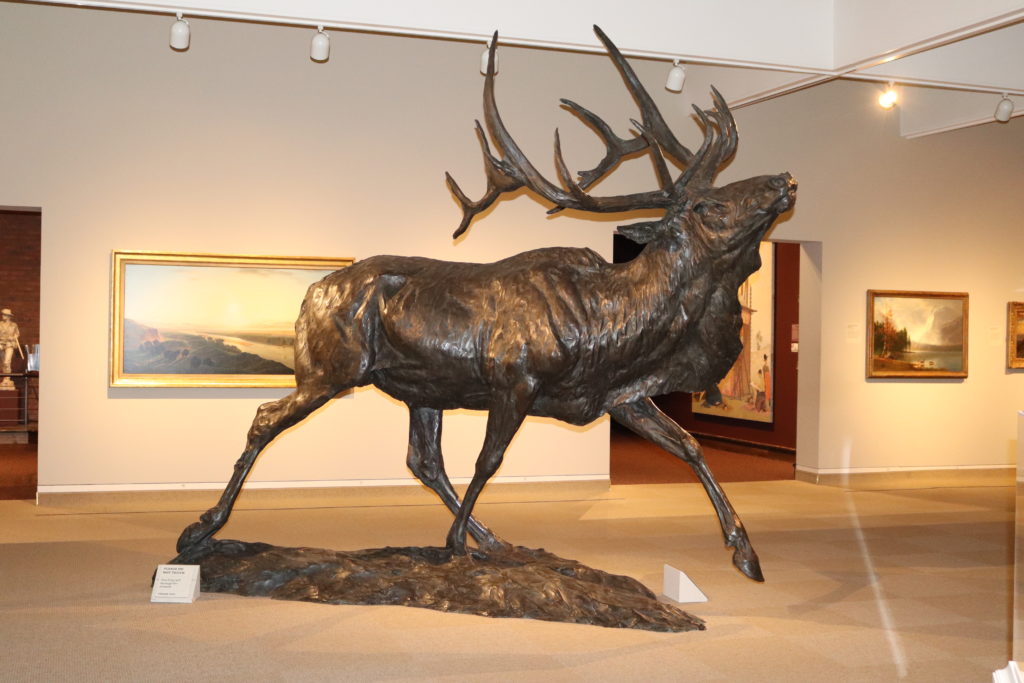
to smaller, table-top sculptures like The Pony Express done in 1967 done by Harry Jackson. Look how it only has one tiny point of attachment to the base and gives the illusion of action.
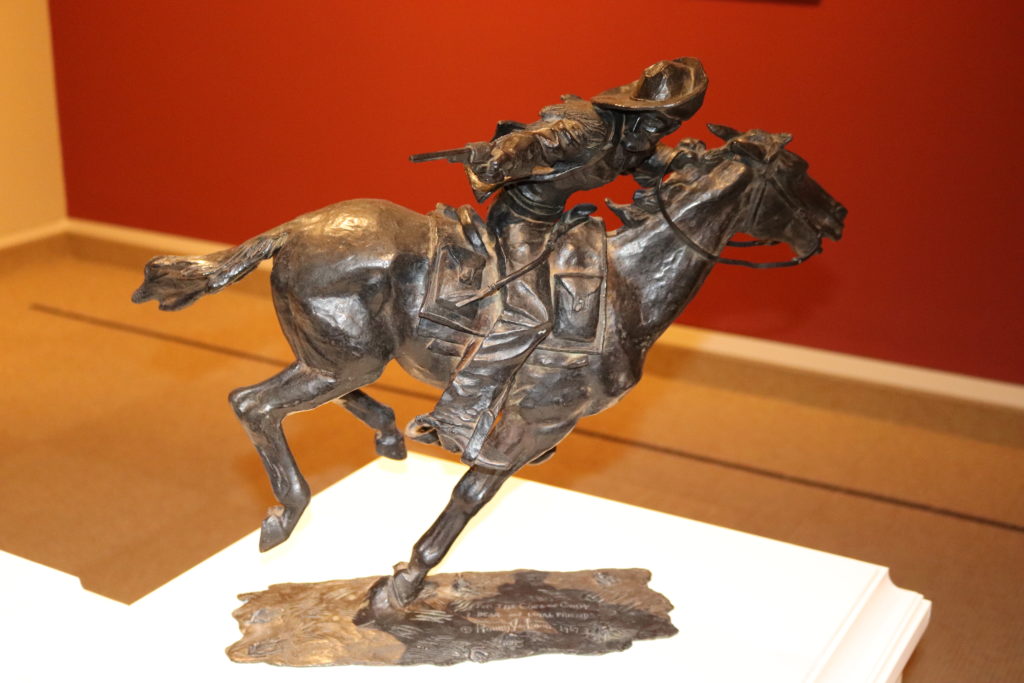
The Wild West Show
Old photographs fascinate me. Here Buffalo Bill is with his sister, Helen Cody Wetmore, in 1890, perhaps discussing a newspaper advertisement for his Wild West Show. Helen lived in and managed a newspaper in Duluth, MN for years before turning her focus to building a sanitorium as “a place for delicate women and children to rest and recuperate.” When it burned to the ground a year later in 1896, she built a home on the site and called it Codyview. In 1905 she moved to Cody, WY and managed the town newspaper which her famous brother gave to her. She died in 1911 in California.
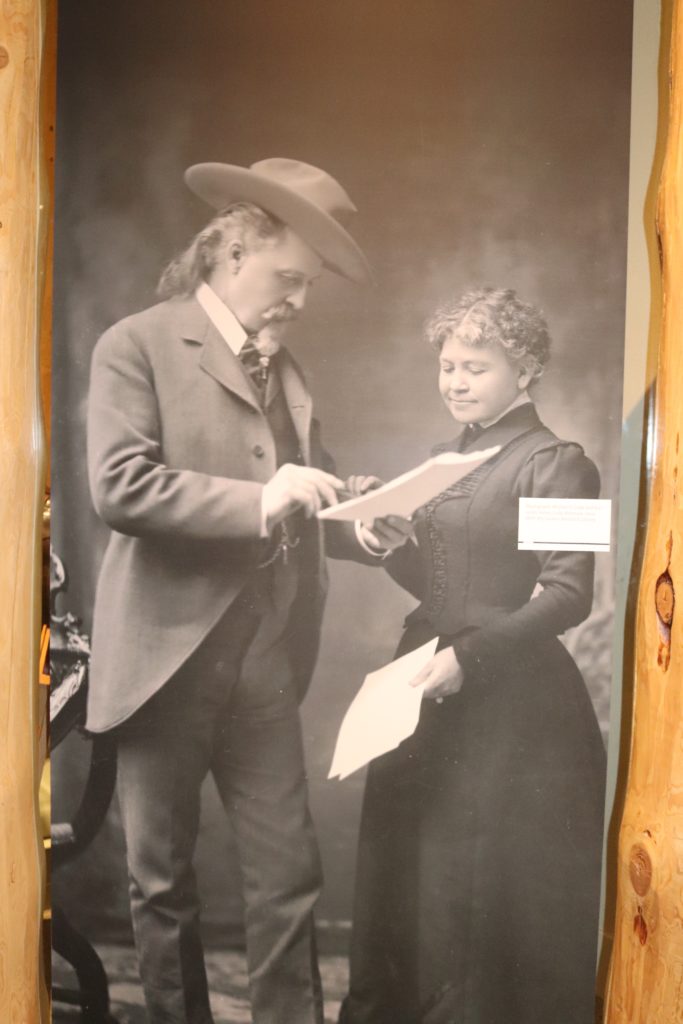
The red pins in this map below show all the towns the Buffalo Bill Wild West Show performed in the US. Did it visit your town?
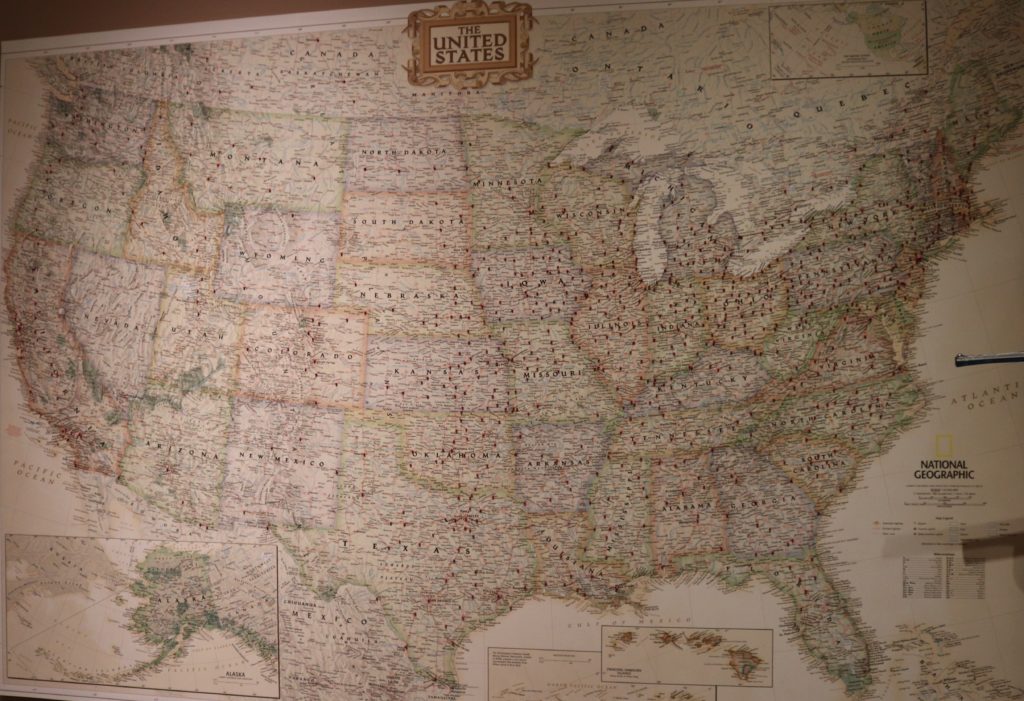
In the next and final part of “Heading West,” I’ll take you to one very familiar spot in America and one that is seldom visited by Americans, both run by the National Park Service.
Catch ya’ all later!
Carolyn
Don’t miss the next post. Please add your email address below to be notified when it comes out! This is a private list and will not be shared.
I really enjoyed learning more about the buffalo. I always wondered when the babies turn dark brown like the adults. And your picture of the yellow-bellied marmot was so cute! You definitely captured all of Yellowstone’s gems and hidden beauties. I am excited to read your last installment because it was my favorite part of the trip. 🙂
Enjoyed your post – thank you! Have been to Yellowstone twice and have not nearly seen it all yet. Is the seldom-visited spot in your next post going to be Theodore Roosevelt NP in western North Dakota? I went there 11 years ago and want to go again – HERDS of bison. (If you haven’t been, I highly recommend it & it’s not crowded.) Your photos are beautiful & you have a gift for writing. Thanks & I look forward to the next installment!
Good guess, DeEtte, but the seldom seen place run by the NPS is not Theodore Roosevelt NP. But based on your recommendation, we will definitely stop there next time! Thanks for you kind encouragement and I can’t wait to hear of your LONG bike trip!